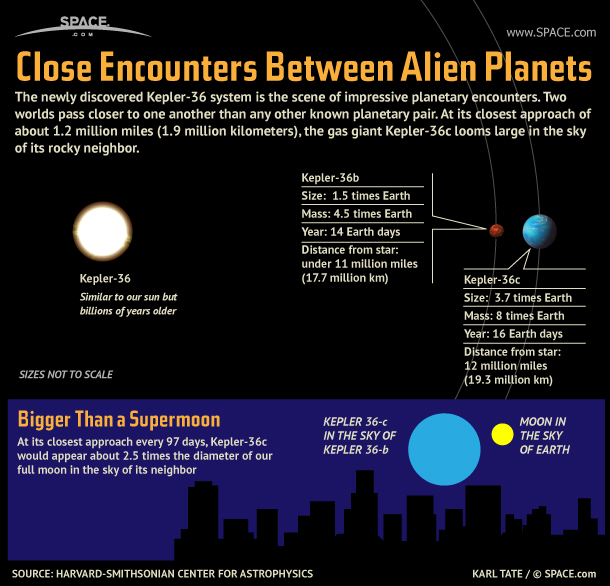Alien Planet Looms Large in Neighbor's Sky (Infographic)

In our solar system, the orbits of the planets are widely spaced apart. For example, the closest planet to Earth, Venus, never comes closer to us than about 41 million miles (66 million kilometers).
In the newly discovered Kepler-36 system, 1,200 light-years from Earth, there are two worlds that pass 30 times closer to each another than any planets in our solar system. Every 97 days on average, two planets of the ancient sunlike star Kepler-36 pass within 1.2 million miles (1.9 million kilometers) of each other.
The planets get so close, an observer on the surface of the inner planet would see its neighbor appear about 2.5 times the diameter of our full moon in the sky. From the outer planet, Kepler-36b appears about the same size as our full moon.
The planets were discovered through astroseismology, the study of how orbiting planets cause a star to resonate.
- Gallery: The Strangest Alien Planets
- Kepler Reveals Lots of Planets: Some Habitable?
- Gallery: A World of Kepler Planets
Breaking space news, the latest updates on rocket launches, skywatching events and more!

Karl's association with Space.com goes back to 2000, when he was hired to produce interactive Flash graphics. From 2010 to 2016, Karl worked as an infographics specialist across all editorial properties of Purch (formerly known as TechMediaNetwork). Before joining Space.com, Karl spent 11 years at the New York headquarters of The Associated Press, creating news graphics for use around the world in newspapers and on the web. He has a degree in graphic design from Louisiana State University and now works as a freelance graphic designer in New York City.
